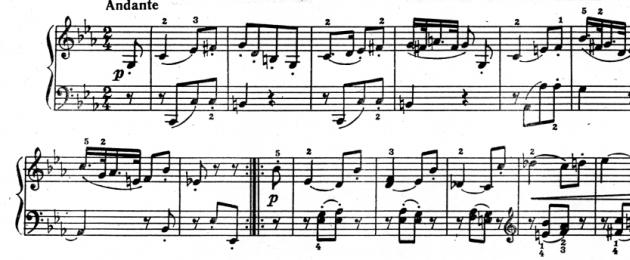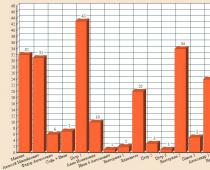Haydn wrote 104 symphonies, the first of which was created in 1759 for the chapel of Count Morzin, and the last - in 1795 in connection with a London tour.
The genre of the symphony in Haydn's work evolved from samples close to everyday and chamber music to the "Paris" and "London" symphonies, in which the classical laws of the genre, the characteristic types of thematics and development techniques were established.
The rich and complex world of Haydn's symphonies possesses remarkable qualities of openness, sociability, and focus on the listener. The main source of their musical language is genre-everyday, song and dance intonations, sometimes directly borrowed from folklore sources. Included in the complex process of symphonic development, they reveal new figurative, dynamic possibilities.
In Haydn's mature symphonies, the classical composition of the orchestra is established, including all groups of instruments (strings, woodwinds, brass, percussion).
Almost all Haydnian symphonies non-program, they don't have a particular plot. The exception is three early symphonies, named by the composer himself "Morning", "Noon", "Evening" (No. 6, 7, 8). All other names given to Haydn's symphonies and fixed in practice belong to the listeners. Some of them convey the general character of the work (“Farewell” - No. 45), others reflect the peculiarities of orchestration (“With a horn signal” - No. 31, “With a tremolo timpani” - No. 103) or accentuate some memorable image (“Bear” - No. 82, "Chicken" - No. 83, "Clock" - No. 101). Sometimes the names of symphonies are associated with the circumstances of their creation or performance ("Oxford" - No. 92, six "Paris" symphonies of the 80s). However, the composer himself never commented on the figurative content of his instrumental music.
Haydn's symphony acquires the meaning of a generalized "picture of the world", in which different aspects of life - serious, dramatic, lyrical-philosophical, humorous - are brought to unity and balance.
Haydn's symphonic cycle usually contains the typical four movements (allegro, andante , minuet and finale), although sometimes the composer increased the number of parts to five (symphonies "Noon", "Farewell") or limited to three (in the very first symphonies). Sometimes, in order to achieve a special mood, he changed the usual sequence of movements (Symphony No. 49 begins with a mournful adagio).
Completed, perfectly balanced and logically arranged forms of parts of the symphonic cycle (sonata, variation, rondo, etc.) include elements of improvisation, remarkable deviations of unexpectedness sharpen interest in the very process of thought development, which is always fascinating and full of events. Favorite Haydnian "surprises" and "pranks" helped the perception of the most serious genre of instrumental music.
Among the numerous symphonies created by Haydn for the orchestra of Prince Nicholas I Esterhazy, a group of minor symphonies of the late 60s - early 70s stands out. This is Symphony No. 39 ( g-moll ), No. 44 (“Funeral”, e- mall ), No. 45 ("Farewell", fis-moll) and No. 49 (f-moll, "La Passione , that is, related to the theme of the suffering and death of Jesus Christ).
"London" symphonies
Haydn's 12 "London" symphonies are considered the highest achievement of Haydn's symphony.
"London" the symphonies (Nos. 93-104) were written by Haydn in England during two tours arranged by renowned violinist and concert entrepreneur Salomon. The first six appeared in 1791-92, six more - in 1794-95, i.e. after Mozart's death. It was in the London Symphonies that the composer created his own stable type of symphony, unlike any of his contemporaries. This Haydn-typical symphony model is different:
All "London" symphonies open slow intros(except for the minor 95th). Introductions perform a variety of functions:
- They create a strong contrast in relation to the rest of the material of the first part, therefore, in its further development, the composer, as a rule, dispenses with a comparison of diverse themes;
- The introduction always begins with a loud statement of the tonic (even if it is of the same name, minor - as, for example, in Symphony No. 104) - which means that the main part of the sonata allegro can begin quietly, gradually and even immediately deviate into another key, which creates the aspiration of the music forward to upcoming climaxes;
- Sometimes the material of the introduction becomes one of the important participants in the thematic dramaturgy. Thus, in Symphony No. 103 (Es-dur, "With a tremolo timpani") the major but gloomy theme of the introduction appears both in the elaboration and in coda I part, and in development it becomes unrecognizable, changing the pace, rhythm and texture.
sonata form in the London Symphonies is very peculiar. Haydn created this type of sonata allegro , in which the main and secondary themes do not contrast with each other and are often generally built on the same material. For example, expositions of symphonies No. 98, 99, 100, 104 are mono-dark. I parts Symphony No. 104( D-dur ) the song and dance theme of the main part is set out by only strings on p , only in the final cadence the whole orchestra enters, bringing with it perky fun (such a technique has become an artistic norm in the London Symphonies). In the section of the side part, the same theme sounds, but only in the dominant key, and in the ensemble with strings now woodwinds alternately perform.
In expositions I parts of symphonies No. 93, 102, 103 side themes are built on an independent, but not contrasting in relation to the main themes material. So, for example, in I parts Symphony No. 103 both themes of the exposition are fervent, cheerful, genre-wise close to the Austrian Lendler, both are major: the main one is in the main key, the secondary one is in the dominant one.
Main Party:

Side party:

in sonatas developments"London" symphonies dominate motivated type of development. This is due to the dance nature of the themes, in which rhythm plays a huge role (dance themes are easier to divide into separate motives than cantilena ones). The most striking and memorable motive of the theme is developed, and not necessarily the initial one. For example, in development I parts Symphony No. 104 the motif of 3-4 measures of the main theme is developed as the most capable of changes: it sounds interrogatively and uncertainly, then menacingly and persistently.
Developing the thematic material, Haydn shows inexhaustible ingenuity. He uses bright tonal comparisons, register and orchestral contrasts, and polyphonic techniques. Topics are often strongly rethought, dramatized, although there are no major conflicts. The proportions of the sections are strictly observed - developments are most often equal to 2/3 of the expositions.
Haydn's favorite form slow parts are double variations, which are sometimes called "Haydnian". Alternating with each other, two themes vary (usually in the same keys), different in sonority and texture, but intonation close and therefore peacefully adjacent to each other. In this form, for example, the famous Andantefrom 103 symphonies: both of his themes are designed in folk (Croatian) color, in both the upward movement from T to D , dotted rhythm, alteration present IV fret stage; however, the minor first theme (strings) has a concentrated narrative character, while the major second (the whole orchestra) is marching and energetic.
First topic:

Second topic:

There are also ordinary variations in the "London" symphonies, as, for example, in Andantefrom 94 symphonies.Here a theme is varied, which is distinguished by its particular simplicity. This deliberate simplicity forces the flow of music to be suddenly interrupted by the deafening blow of the entire orchestra with timpani (this is the "surprise" with which the name of the symphony is associated).
Along with the variation, the composer often uses in slow parts and complex tripartite shape, as, for example, in Symphony No. 104. All sections of the three-part form here contain something new in relation to the initial musical thought.
By tradition, the slow parts of sonata-symphony cycles are the center of lyrics and melodious melody. However, Haydn's lyrics in symphonies clearly gravitate towards genre. Many of the themes of the slow movements are based on a song or dance basis, revealing, for example, the features of a minuet. It is significant that of all the "London" symphonies, the remark "melodious" is present only in the Largo 93 symphony.
Minuet - the only movement in the symphonies of Haydn, where there is a mandatory internal contrast. Haydn's minuets became the standard of vitality and optimism (it can be said that the composer's individuality - the traits of his personal character - manifested itself most directly here). Most often these are live scenes of folk life. Minuets prevail, carrying the traditions of peasant dance music, in particular, the Austrian Lendler (as, for example, in Symphony No. 104). A more gallant minuet in the "Military" symphony, whimsically scherzo (thanks to the sharp rhythm) - in Symphony No. 103.
Minuet of Symphony No. 103:

In general, the accentuated rhythmic sharpness in many of Haydn's minuets alters their genre appearance to such an extent that, in essence, it leads directly to Beethoven's scherzos.
Minuet form - always complex 3-part da capo with a contrasting trio in the center. The trio usually contrasts gently with the main theme of the minuet. Very often only three instruments really play here (or, in any case, the texture becomes lighter and more transparent).
The finales of the "London" symphonies are without exception major and joyful. Here, Haydn's predisposition to the elements of folk dance was fully manifested. Very often, the music of the finals grows out of truly folk themes, as in Symphony No. 104. Its finale is based on a Czech folk melody, which is presented in such a way that its folk origin is immediately obvious - against the backdrop of a tonic organ point imitating bagpipes.
The finale maintains symmetry in the composition of the cycle: it returns to the fast tempo I parts, to effective activity, to a cheerful mood. final form - rondo or rondo sonata (in Symphony No. 103) or (less commonly) - sonata (in Symphony No. 104). In any case, it is devoid of any conflicting moments and rushes by like a kaleidoscope of colorful festive images.
If in Haydn's earliest symphonies the wind group consisted of only two oboes and two horns, then in the later, London symphonies, a complete paired composition of woodwinds (including clarinets) is systematically found, and in some cases also trumpets and timpani.
Symphony No. 100, G-dur was called "Military": in its Allegretto, the audience guessed the ceremonial course of the guards parade, interrupted by the signal of the military trumpet. In No. 101, D-dur, the Andante theme unfolds against the background of the mechanical "ticking" of two bassoons and pizzicato strings, in connection with which the symphony was called "The Hours".
- In contact with 0
- Google Plus 0
- OK 0
- Facebook 0








